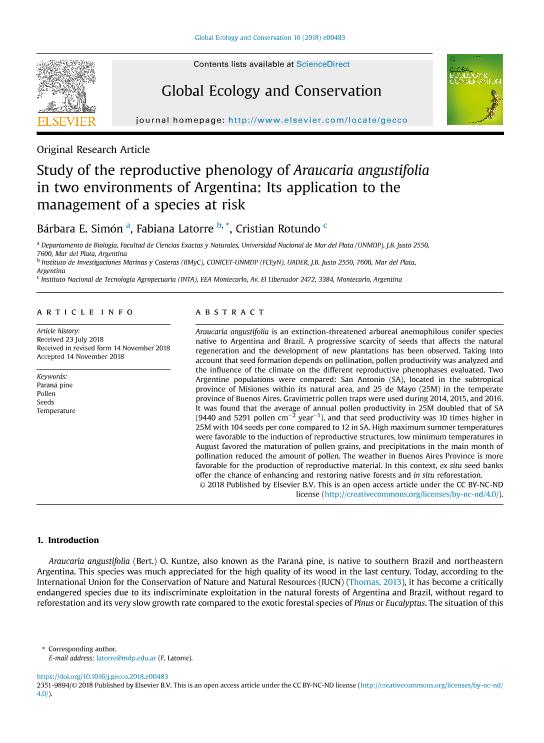Artículo
Study of the reproductive phenology of Araucaria angustifolia in two environments of Argentina: Its application to the management of a species at risk
Fecha de publicación:
11/2018
Editorial:
Elsevier
Revista:
Global Ecology and Conservation
ISSN:
2351-9894
Idioma:
Inglés
Tipo de recurso:
Artículo publicado
Clasificación temática:
Resumen
Araucaria angustifolia is an extinction-threatened arboreal anemophilous conifer species native to Argentina and Brazil. A progressive scarcity of seeds that affects the natural regeneration and the development of new plantations has been observed. Taking into account that seed formation depends on pollination, pollen productivity was analyzed and the influence of the climate on the different reproductive phenophases evaluated. Two Argentine populations were compared: San Antonio (SA), located in the subtropical province of Misiones within its natural area, and 25 de Mayo (25M) in the temperate province of Buenos Aires. Gravimetric pollen traps were used during 2014, 2015, and 2016. It was found that the average of annual pollen productivity in 25M doubled that of SA (9440 and 5291 pollen cm−2 year−1), and that seed productivity was 10 times higher in 25M with 104 seeds per cone compared to 12 in SA. High maximum summer temperatures were favorable to the induction of reproductive structures, low minimum temperatures in August favored the maturation of pollen grains, and precipitations in the main month of pollination reduced the amount of pollen. The weather in Buenos Aires Province is more favorable for the production of reproductive material. In this context, ex situ seed banks offer the chance of enhancing and restoring native forests and in situ reforestation.
Palabras clave:
PARANÁ PINE
,
POLLEN
,
SEEDS
,
TEMPERATURE
Archivos asociados
Licencia
Identificadores
Colecciones
Articulos(IIMYC)
Articulos de INSTITUTO DE INVESTIGACIONES MARINAS Y COSTERAS
Articulos de INSTITUTO DE INVESTIGACIONES MARINAS Y COSTERAS
Citación
Simón, Bárbara E.; Latorre, Fabiana; Rotundo, Cristian Andrés; Study of the reproductive phenology of Araucaria angustifolia in two environments of Argentina: Its application to the management of a species at risk; Elsevier; Global Ecology and Conservation; 16; 11-2018; 1-12
Compartir
Altmétricas




